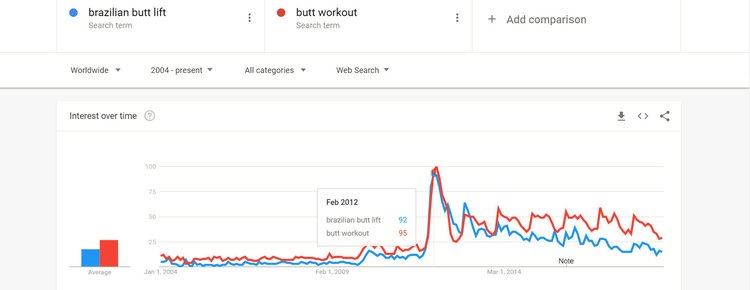Only 10 years ago — just when I was in my last year of college — magazine covers and TV commercials featured mostly skinny model-like girls, female cleavage zone was occasionally in the spotlight, and when buying jeans we opted for those that didn’t make our butts look big. However, for the past years, one particular body part has dominated media channels. Let’s see why and how people started obsessing over the female backside.
How it all began
A sizable female derriere had been gradually rising in popularity since 2000, peaked between 2012 and 2014, and is still on point. In 2014, Vogue wrote that there was a “cultural obsession with butts,” and explained it was actually Jennifer Lopez who kicked it off. Vogue quoted Miami-based plastic surgeon Dr. Constantino G. Mendieta who said that people started asking how they could get a backside like Lopez after they saw her at the 2000 Grammys rocking the barely-there green Versace gown, she seems to be channeling in her recent InStyle Photoshoot.
Beyoncé, who already rose to stardom by that time, is also a perfect example of how gorgeous a woman can look even if she does not fit into the specific proportions of 36–24–36 inches.
However, it wasn’t until the early 2010s when female bodies ‘like an hourglass’ started getting that much media attention. According to Google Trends, in February 2012, people’s interest in butt-related topics, such as ‘brazilian butt lift, butt workout, and butt augmentation, skyrocketed.
It comes as no surprise that February 2012 was when Kim Kardashian West, the woman who turned her backside into a brand, got on Instagram, and Nicki Minaj released her album ‘Pink Friday: Roman Reloaded'.
Actually, “who started the butt trend” is kind of like a hen and egg problem: Kim Kardashian and Nicki Minaj — the two women with most famous butts out there — started gaining increased attention in August 2011, each for reasons of her own and not directly related to their backsides. It looks like seeing women with curves across multiple media channels first changed people’s perspective on what body type was attractive and gradually made it turned it into a trend.
Also, in May 2012, Instagram user base reached 50 million people (in September 2011 it was only 10), which made it easier for beauty trends to pick up.
Why are people obsessed with big butts?
There are many theories surrounding the cause of this modern obsession with big butts: from Internet ubiquity to cultural decline. However, the scientific explanation is as follows: women with wider hips and lower spine angle of 45 degrees are believed to have fewer complications while delivering a baby. So it’s only natural that big and protruding backsides are considered attractive.
Others believe that it all started with internet porn at the dawn of the 21st century: as the Internet’s rise made porn so accessible, bottoms literary got into focus.
Impact
Opinions differ on whether this big booty trend is a good or a bad thing: some say that it is empowering women, while others believe that fetishizing any part of human body is unhealthy. Still, it has definitely revolutionized beauty standards, spun a number of businesses, and made a huge impact on the modern culture.
According to statistics, the number of people getting buttock augmentation is growing somewhat slower — in 2017, it grew by 10%. In 2014, Dr. Constantino G. Mendieta said to Vogue that number “went up 53 percent from the previous year.”
The year of 2014 was a big one for butts: Kim Kardashian broke the Internet with her nude photo shoot for Paper magazine, Nicki Minaj released her Anaconda video — the events which made a number of google searches for 'butt implants' spike. Meanwhile, Jennifer Lopez, the pioneer of the trend, teamed up with Iggy Azalea to sing about a big booty. By the way, Iggy Azalea herself might have had to endure a little distortion of the rear end to get into the right shape for that video.
To get a perfect rear people also changed the way they workout: opting for heavier squats and lunges — toned glutes became as desirable as abs. Instagram fitness models like Sommer Ray and Jen Selter look nothing like Jane Fonda.
If it wasn’t for the big booty trend, twerking might not have gained its momentum either. Born in New Orleans in the 1990s, the raunchy dance move owes its rise to prominence to Miley Cyrus of all people: she learned to twerk in 2010 and started including twerking in her dance routine. In August 2013 she twerked at the VMAs during her duet with Robin Thicke, spinning an avalanche of memes and backlashes. Suddenly so many people were into twerking that the Oxford English Dictionary added the word to its vocabulary.
While popularising certain body shapes remains a polarizing subject, people’s interest in it was a huge leap for body positivity movement — plus-size models have a mass following in Instagram and land magazine covers.
What’s next?
As the big booty trend seems to subside in the media, fewer people are willing to undergo plastic surgery procedures. Celebrity dermatologist Dr. Harold Lancertold Pret-a-Reporter that operations on “cleavage lines” were surpassing butt augmentation popularity.
"The big booty trend may have quieted in the media, but there are still those who find a large rear desirable. During the height of the craze, I would have clients do a lot of heavier squats, lunges, and leg curls to develop the buttocks and hamstring area. When Michelle Obama was the first lady and going sleeveless, people did more curls, presses and shoulder work to sculpt their arms. Now I think there is more of an emphasis on overall strength and athleticism as an outgrowth of the Me Too movement where women want to be stronger and more assertive," Robert S. Herbst, personal trainer, weight loss, and wellness coach said to ihodl.
No matter how long the trend lasts and what comes after, it sure changed what we consider conventionally beautiful.



